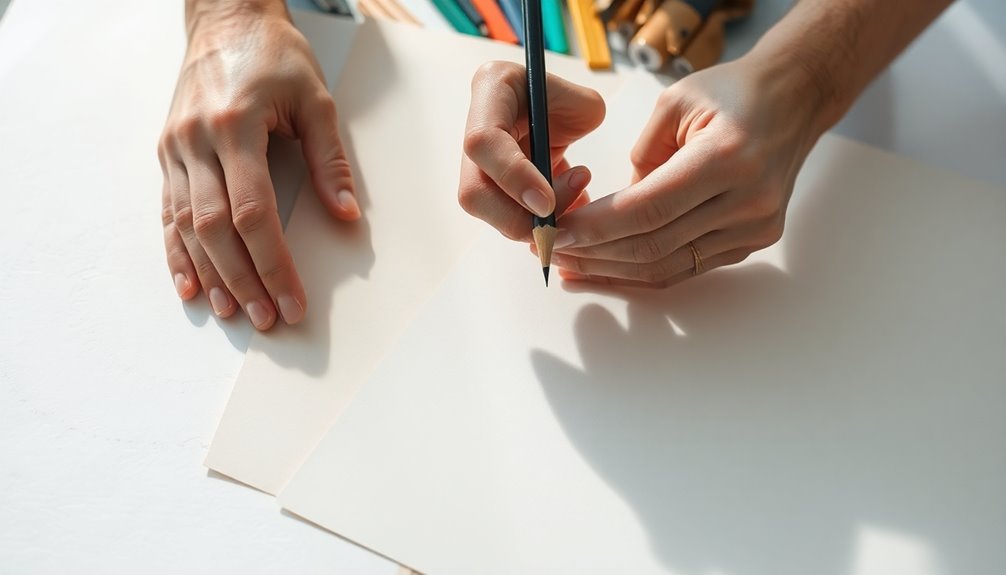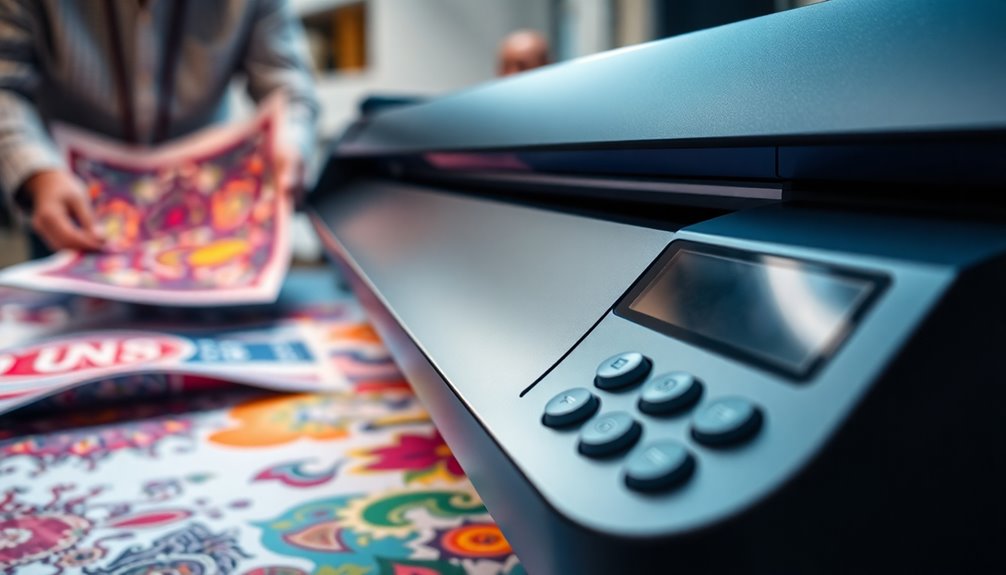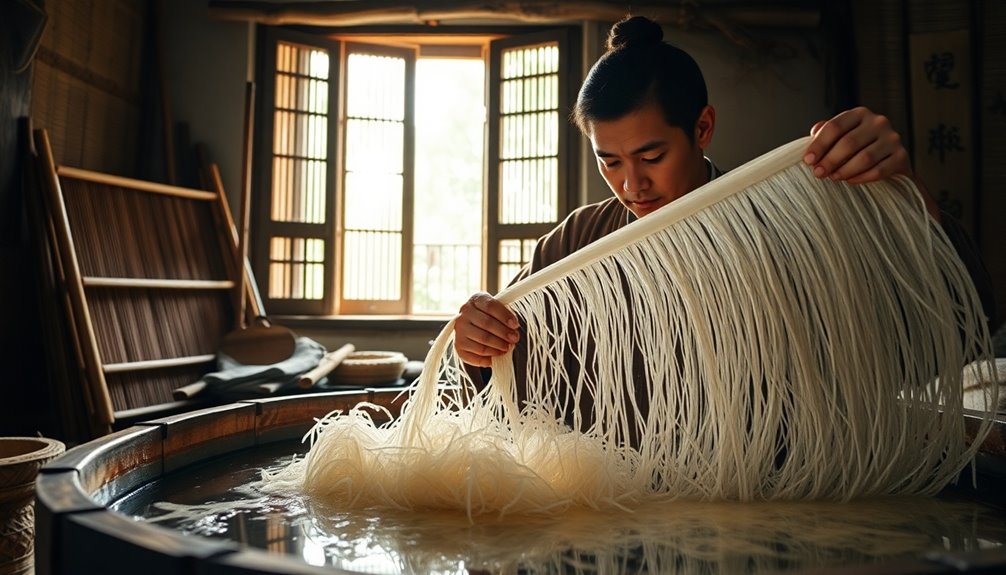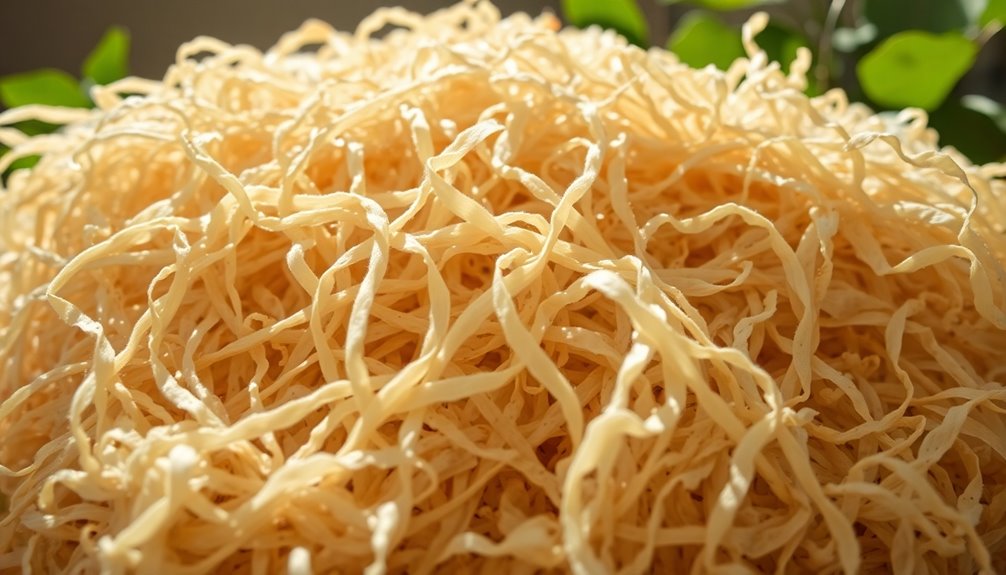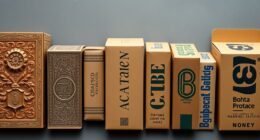Choosing the right drawing paper is essential for your artwork's success. Start by considering weight; heavier paper (200-300 gsm) is perfect for mixed media, while lighter options suit sketching. Next, look at texture—smooth surfaces are great for fine details, while textured paper enhances depth. Don't forget the importance of acid-free paper to prevent deterioration. Experiment with different types like Bristol board or cotton for unique finishes. Each paper type offers benefits tailored to your medium. By exploring your options, you'll make informed choices that elevate your art. Keep going to discover even more helpful tips and recommendations!
Key Takeaways
- Assess the paper's weight (gsm) to ensure it suits your chosen technique and medium for durability and performance.
- Consider the texture of the paper, as it influences detail rendering and shading capabilities.
- Choose acid-free paper to prevent deterioration and yellowing over time, ensuring artwork longevity.
- Experiment with different types of paper to discover which best enhances your artistic style and techniques.
- Research recommended papers for specific mediums, such as watercolor or charcoal, to achieve optimal results.
Importance of Paper Selection
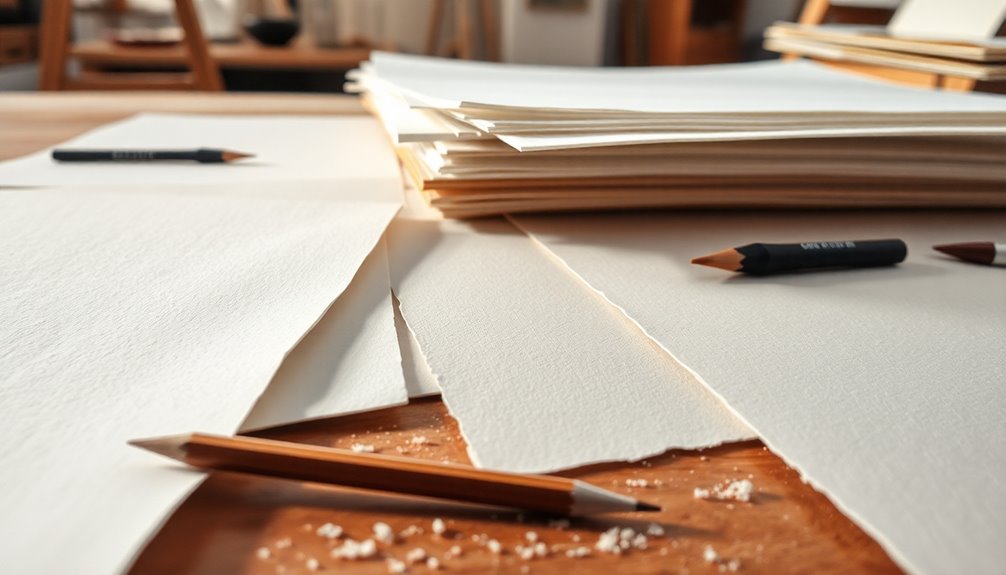
When it comes to your artwork, the right paper can make all the difference. Selecting the appropriate drawing paper isn't just a matter of preference; it greatly influences the final outcome of your creations.
You'll want to take into account the texture, weight, and whether the paper is acid-free. Each of these factors plays an essential role in how your chosen medium interacts with the paper.
Acid-free paper is important for ensuring your artwork lasts without deteriorating or yellowing over time. If you're working with techniques that require layering, heavier papers, typically weighing between 200-300 gsm, are your best bet. They can withstand the pressure and multiple applications of mediums.
Lighter papers, on the other hand, may buckle under heavy use, leading to a frustrating experience.
To make informed choices, research artist recommendations and experiment with various paper types. Testing different options will help you understand how each one responds to your unique artistic style and goals.
Key Characteristics of Drawing Papers
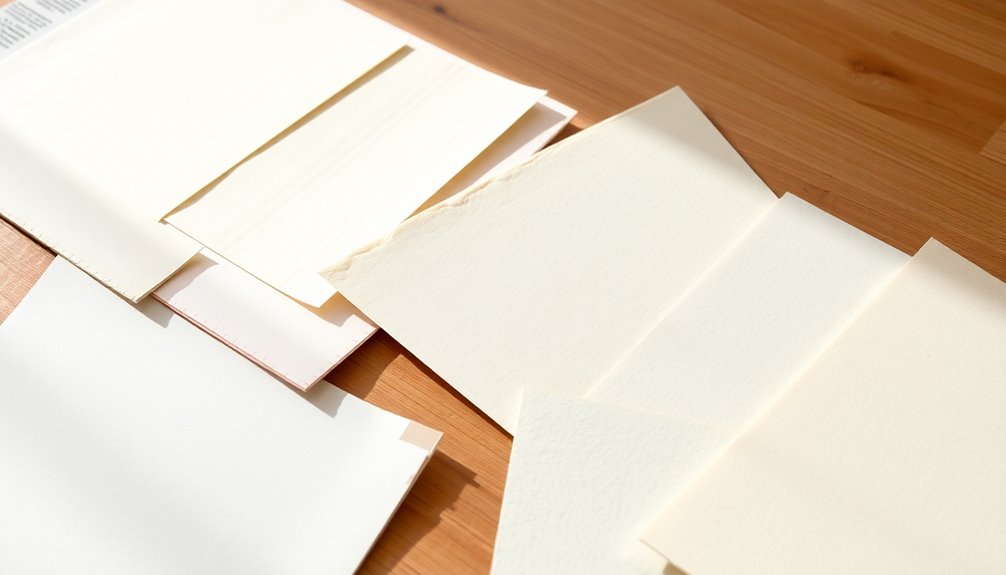
Selecting the right drawing paper involves understanding its key characteristics, which can greatly enhance your artistic process. One important factor is the weight of the paper, measured in grams per square meter (gsm). For heavier applications like watercolor or multiple graphite layers, look for papers in the 200-300 gsm range, as they provide the durability you need.
Another critical aspect is surface texture. A smooth surface works best for fine detail and shading, while a textured surface can improve adherence and depth, making it ideal for natural subjects. Consider how the texture will affect your work and choose accordingly.
Don't overlook the importance of acid-free papers. These are essential for preserving your artwork over time, preventing yellowing and deterioration that can compromise your pieces. For professional quality, opt for papers made from 100% cotton, which offer archival qualities and resistance to wear.
Finally, specialty papers like Bristol board come with unique finishes, such as a smooth surface for detailed illustrations or a slightly textured vellum. Each choice impacts the final outcome, so make sure to select the paper that aligns with your artistic vision.
Types of Drawing Paper
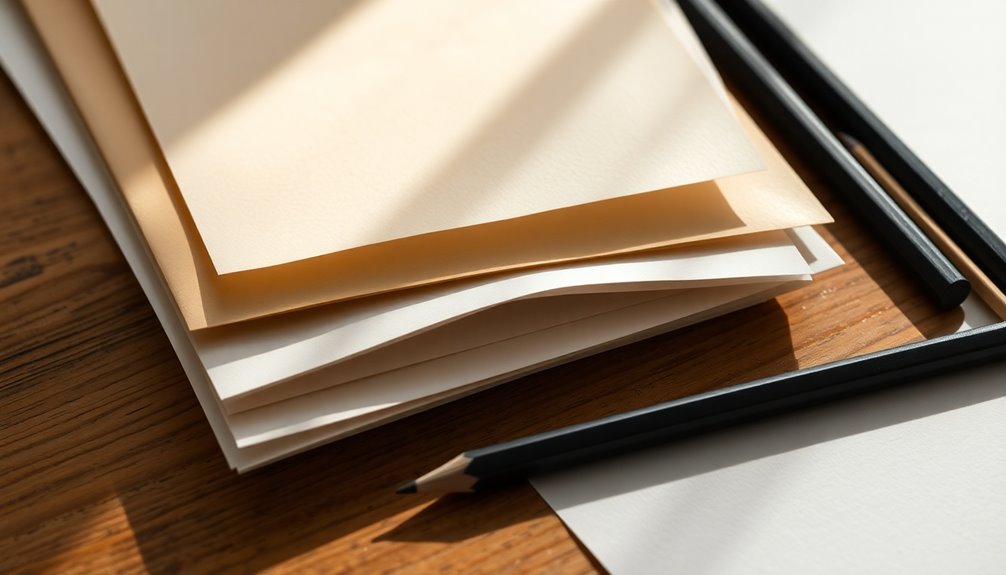
When choosing drawing paper, the type you select can greatly impact your artwork.
You'll want to contemplate factors like paper texture, weight, and specialty options tailored to specific mediums.
Each type of paper offers unique advantages, so understanding your needs is key to achieving the best results.
Paper Texture Importance
The texture of drawing paper plays a crucial role in shaping your artwork's final appearance. Understanding paper texture can help you select the right surface for your specific needs.
If you prefer a smooth surface, hot pressed papers like Saunders Waterford HP+ are perfect for fine detail and smooth shading techniques. These papers allow for clean lines and precise erasures, making them ideal for intricate work.
On the other hand, if you're looking to create depth and interest, consider cold pressed papers such as Bockingford CP(NOT). Their rougher texture captures natural elements beautifully and enhances the adherence of graphite, which is excellent for textured subjects.
Experimenting with different types of paper texture allows you to discover unique effects, as each paper interacts differently with various mediums.
Whether you choose smooth or textured surfaces, remember that your choice can greatly impact your artwork's outcome.
Weight and Thickness
Understanding the different weights and thicknesses of drawing paper is just as important as knowing its texture. The weight, measured in grams per square meter (gsm), affects the paper's durability and suitability for various techniques. Lighter papers, around 90 gsm, work well for sketching, but they may buckle under wet media. Heavier options, ranging from 200 to 300 gsm, are perfect for watercolor and can handle moisture without warping.
Here's a quick comparison of common drawing paper weights and their characteristics:
| Weight (gsm) | Thickness | Ideal Use |
|---|---|---|
| 90 | Thin | Sketching |
| 150 | Medium | Pencil and ink work |
| 200 | Thick | Mixed media |
| 300 | Very Thick | Watercolor, heavy applications |
Thicker papers provide better resistance to tearing and allow for multiple layers of graphite or other media. Choosing the right weight and thickness is essential; it affects not just the technique you use but also the quality and longevity of your final artwork.
Specialty Paper Types
Choosing the right specialty paper can elevate your drawing experience and results. Each type serves unique purposes, so it's crucial to know what fits your needs.
Cartridge Paper is a heavyweight option, usually around 220 gsm, known for its durability. It comes in smooth, medium, and coarse grains, making it versatile for various drawing techniques, from graphite to colored pencils.
Watercolor Paper is designed for wet media and typically made from cotton to guarantee it's acid-free. Hot press varieties offer a smooth surface, perfect for detailed work, while cold press and rough options add texture, enhancing the watercolor effects.
Bristol Board is another great choice, featuring smooth and vellum surfaces. It's ideal for detailed illustrations and ink work. The smooth variant excels in fine line work, while the vellum surface suits softer applications, like blending colored pencils.
Don't forget about other options like pastel paper, which is textured for holding pastel particles, and mixed media paper, which accommodates various techniques.
Recommended Papers for Different Techniques
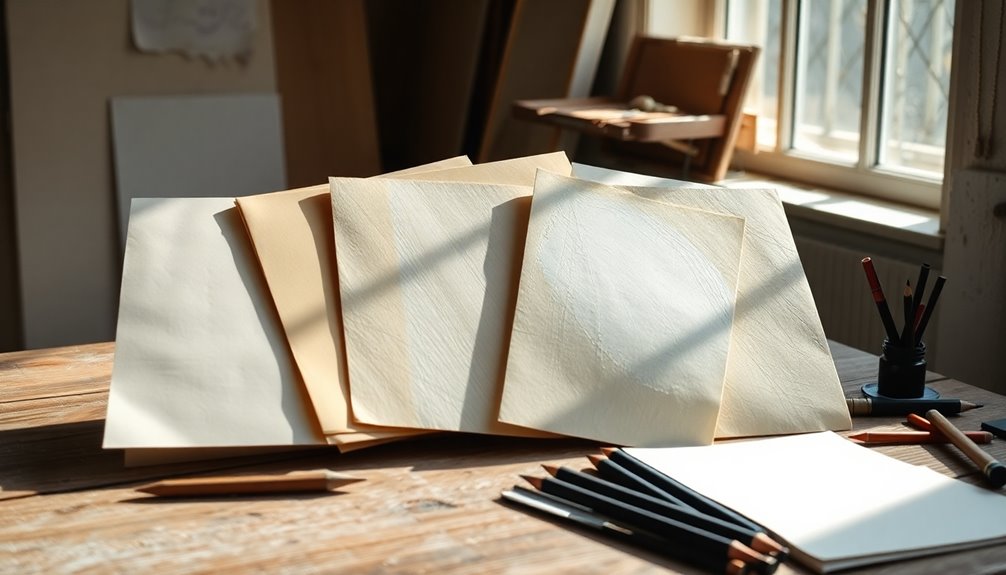
Artists frequently face the challenge of selecting the right drawing paper for their specific techniques. Choosing the right texture can make a significant difference in your artwork. Here are some recommended papers tailored for various techniques:
| Paper Type | Best For | Texture |
|---|---|---|
| Canson Classic Cream Drawing Paper | Quick sketches | Softer, rough |
| Strathmore 500 Bristol Pad (Plate) | Detailed illustrations | Very smooth |
| Strathmore 400 Series Bristol Smooth | General drawings | Consistent smoothness |
| Canson Drawing Paper Smooth Surface | Light sketches | Inconsistent tooth |
| Arches Watercolor Paper | Ink and watercolor blending | Smooth hot-pressed |
If you're looking for a softer texture for darker values, Canson Classic Cream is a great choice. For delicate details, go with the Strathmore 500 Bristol Pad. Strathmore 400 is an economical pick for everyday use, while Canson Drawing Paper may not suit serious graphite work. Finally, Arches Watercolor Paper excels at blending mediums. Your choice should reflect your technique and desired outcome!
Historical Usage of Drawing Papers
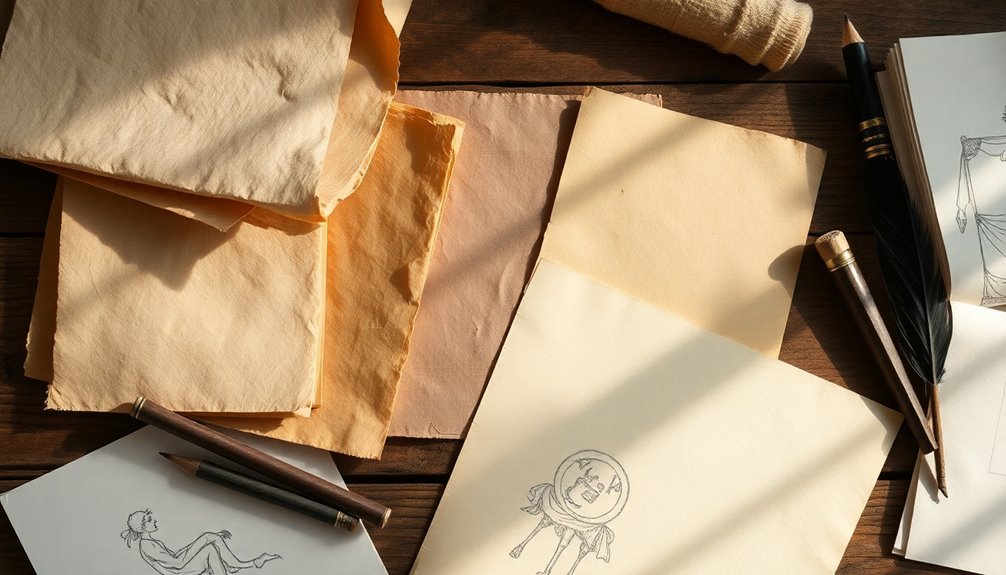
When you look at the history of drawing papers, you'll notice that artists had specific preferences that shaped their techniques.
For example, Vincent van Gogh used sketch paper for initial ideas, while Rembrandt chose high-quality drawing paper for his detailed works.
Understanding these historical choices can help you appreciate how the right paper influences artistic expression and outcomes.
Artists' Paper Preferences
Throughout history, many artists have made deliberate choices about the drawing paper they use, recognizing its impact on their creative process. The preference for specific types of drawing paper often reflected their artistic goals and techniques.
Take a look at how different artists approached paper selection:
| Artist | Paper Preference |
|---|---|
| Vincent van Gogh | Lightweight sketch paper for preliminary drawings |
| Rembrandt | High-quality drawing paper for finished pieces and studies |
| Mary Cassatt | Pastel paper to enhance soft media application |
Artists like Ingres and Panini also showcased the importance of using specialized papers to achieve precision and detail in their works. The choice of drawing paper greatly influenced their techniques and the overall quality of their finished pieces.
Techniques and Paper Types
Many renowned artists understood that the choice of drawing paper directly influenced their techniques and overall outcomes. For instance, Van Gogh often used sketch paper for quick studies, highlighting its practicality. In contrast, Rembrandt selected high-quality drawing paper for his final pieces, showcasing how paper types can elevate detail and polish in artwork.
As you explore various drawing papers, consider these important factors:
- Texture: Rough, smooth, or textured surfaces can affect how your medium interacts with the paper.
- Weight: Heavier papers provide durability, allowing for various techniques without degradation.
- Medium Compatibility: Some papers, like those favored by Cassatt and Degas for pastels, are specifically designed to enhance certain mediums.
Artists like Ingres preferred specialized papers to match their detailed techniques, demonstrating that the right paper can complement your style.
Understanding the historical usage of drawing papers will help you make informed choices that align with your artistic goals. By selecting the appropriate drawing paper, you can enhance your techniques and achieve the desired outcomes in your artwork.
Historical Materials Used
Historical artists carefully chose their drawing papers, often selecting materials that suited their specific techniques and styles. For instance, Van Gogh preferred lightweight sketching paper for quick ideas, while Rembrandt opted for heavier drawing papers, which enhanced textures and detail in his finished works. The choice of paper greatly influenced the artistic outcome, as seen in the practices of Ingres and Panini, who used specialized papers to achieve their detailed styles.
Moreover, Mary Cassatt and Edgar Degas often favored pastel paper, which complemented their impressionist techniques and the representation of color. Even newsprint found its place in initial sketches, demonstrating a practical approach that prioritized concept over quality.
Here's a table summarizing these historical materials:
| Artist | Type of Paper | Purpose | Characteristics |
|---|---|---|---|
| Van Gogh | Lightweight Sketch Paper | Preliminary sketches | Captures quick ideas |
| Rembrandt | Heavier Drawing Paper | Finished works | Rich textures and detail |
| Ingres & Panini | Specialized Drawing Paper | Detailed artwork | Enhances specific styles |
| Cassatt & Degas | Pastel Paper | Impressionist drawings | Unique texture for color |
Understanding these choices can help you in selecting the right drawing papers for your own artistic journey.
Specialty Papers for Specific Needs
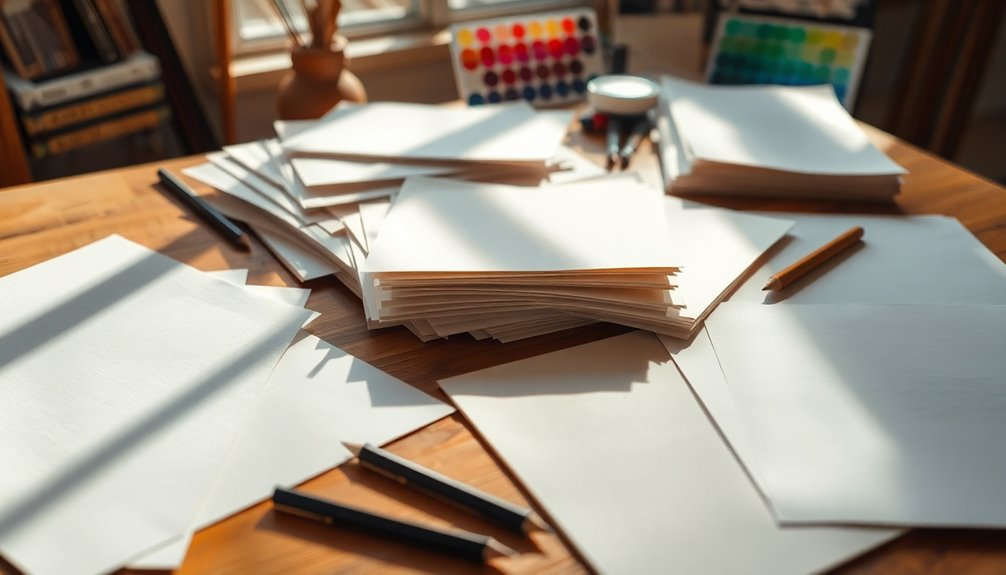
When it comes to choosing the right paper for your artistic needs, specialty papers can make a significant difference in your work's outcome. Each type is tailored for specific mediums, enhancing your creative process and results.
- Bristol Paper: This versatile option comes in smooth and vellum finishes, perfect for intricate details and fine line work.
- Mixed Media Paper: If you love experimenting, this paper accommodates various media, from acrylics to watercolors, allowing you to combine techniques seamlessly.
- Pastel Paper: Designed with a pebbled surface, it effectively retains pastel and colored pencil, enabling you to build vibrant layers without smudging.
Selecting the right specialty paper is vital for achieving the desired effects in your artwork. For fine line art, Bristol Paper's smooth finish is unbeatable.
If you're working with pastels or charcoal, consider Pastel Paper or Charcoal Paper for ideal control and application.
For those who enjoy combining different media, Mixed Media Paper will support your artistic experimentation.
Community Insights and Experiences

Engaging with a community of artists can greatly enrich your understanding of drawing paper choices. By sharing experiences and recommendations, you can discover which papers enhance your artistic techniques. Many artists emphasize the importance of paper weight, with 300 gsm often being a favorite for its durability and ability to support multiple layers of graphite.
You'll also find that discussions frequently revolve around experimenting with different textures, like smooth versus rough papers, to achieve unique effects in various styles. Here's a glimpse of popular paper preferences among artists:
| Paper Type | Key Features | Recommended Use |
|---|---|---|
| 300 gsm Cold Press | Acid-free, textured surface | Watercolor, mixed media |
| 200 gsm Smooth | Acid-free, smooth finish | Graphite, ink |
| 250 gsm Drawing | Archival quality, versatile | General drawing |
| 350 gsm Bristol | Heavyweight, durable | Colored pencils, markers |
| 180 gsm Newsprint | Affordable, lightweight | Sketching, practice |
Frequently Asked Questions
What Type of Paper Is Best for Drawing?
When you're deciding what type of paper is best for drawing, think about your medium and technique.
If you prefer detailed work, go for smooth, heavyweight paper like Saunders Waterford HP+.
For textured subjects, consider cold-pressed paper like Bockingford CP.
If you're looking for versatility, 100% cotton options like Stonehenge excel with graphite.
Remember to choose acid-free papers to guarantee your artwork lasts, and always match the paper to your specific drawing needs.
What Are the Qualities of a Good Drawing Paper?
A good drawing paper has several essential qualities.
First, it should be acid-free to prevent yellowing over time.
You'll want to take into account the weight, too; heavier papers (200-300 gsm) can handle layering without warping.
Texture matters as well—smooth papers work for detailed pieces, while textured ones add depth.
Look for quality materials, like 100% cotton, which guarantee durability.
Finally, it should allow clean erasing without damage, making your creative process smoother.
Is Smooth or Rough Paper Better for Drawing?
You'll find that choosing between smooth or rough paper depends on your drawing style and subject matter.
If you're aiming for detailed work and smooth shading, smooth paper's your best bet.
However, if you want to capture texture, rough paper will enhance your natural elements.
Experiment with both to discover what suits your technique and vision.
Each type offers unique results, so don't hesitate to try them out!
What Is the Difference Between Sketching Paper and Drawing Paper?
When you're deciding between sketching paper and drawing paper, it's important to know their differences.
Sketching paper is lighter and often smoother, perfect for quick studies.
Drawing paper, on the other hand, is heavier and has varying textures, making it suitable for finished artwork.
You'll find that drawing paper can handle more layering and erasing without damage, while sketching paper may tear or dent under pressure.
Choose based on your project's needs!
Conclusion
In choosing the right drawing paper, you're not just selecting a surface; you're setting the stage for your creativity. Remember to reflect on the key characteristics and types of paper that align with your techniques. Whether you're sketching, inking, or using mixed media, the right paper can elevate your artwork. Don't hesitate to experiment with specialty papers and learn from community insights. Ultimately, the best paper for you is one that inspires your artistic expression. Keep creating!

